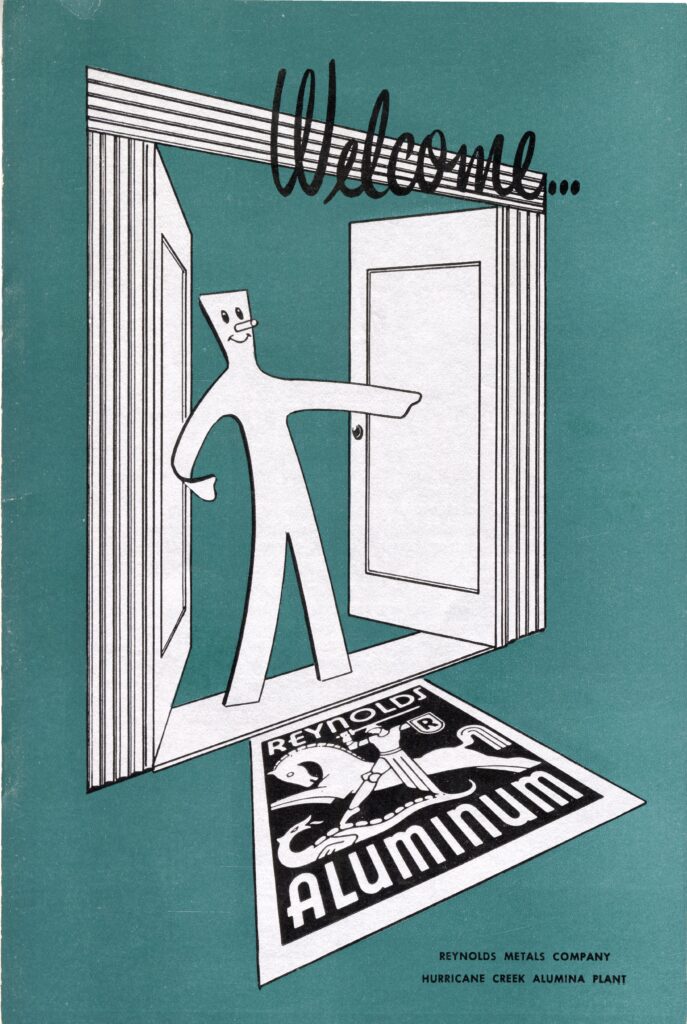The Reynolds Story

By Cody Berry
There were two companies that competed for dominance in the bauxite fields of Saline County: the Aluminum Company of America, aka Alcoa, and the Reynolds Metals Company which may know as the makers of aluminum foil today. Reynolds started its life in 1928 as a subsidiary of the U. S. Foil Company. Richard S. Reynolds founded the United States Foil Company in 1919 after he and his brothers left the R. J. Reynolds Tobacco Company to make tin foil, (and eventually aluminum foil) wrappings for cigarettes.1
After World War Two began Richard Reynolds contacted President Franklin Roosevelt and testified before the United States Senate about the need for aluminum for the war effort. Reynolds believed in this so much that he leveraged all his assets for a loan from the government to build another factory for the production of aluminum. A brochure I found at the Gann Museum said that Reynolds built plants at Listerhill, Alabama and Longview, Washington.2
From 1941 to 1945, when the U.S. was involved in WWII, Reynolds Metals delivered nearly 20 million pounds of parts to the air forces. Almost a billion pounds of Reynolds aluminum products went into planes, bombs, radio, radar, and overseas packaging.3 The Hurricane Creek Alumina Plant in Bauxite was built by the government during WWII and it was leased by the Reynolds Metals Company after WWII from 1946 until they purchased it in 1949. It was operated by a subsidiary called the Reynolds Mining Corporation.4 By that time, Reynolds changed its focus and began producing household products like Reynolds Wrap.5
According to one of the brochures I found, the Hurricane Creek Plant had a yearly capacity of 1,555,000,000 pounds of alumina, making it the largest of its type in the world at the time.6 The plant was used by Reynolds to process the ore into alumina which was then sent to reduction plants in Arkansas, Alabama, Oregon, and Washington to be turned into “pig,” an industry term for aluminum ingots.7 The ingots were then shipped to foundries and mills where they would be used to make sheet metal or aluminum foil.8
Some people living in Saline County today may not know that Hurricane Lake was built to service the Hurricane Creek Plant. Construction on Hurricane Lake began in 1942 and the dam there was finished in 1943. While the water was used for processing ore, the lake itself was also used for recreation by the employees and their families.9 The last bauxite ore to be extracted by the Hurricane Creek Plant was mined in February 1983. Eventually, the plant closed, and most of it was torn down in the mid-1980s. The spot where it once stood is a mostly vacant field on South Reynolds Road near its intersection with West Sardis Road in Bauxite.
Citations:
1 Reynolds Metals Company. “Welcome…,” Hurricane Creek Alumina Plant, Brochure, p. 1-2. and Richard Reynolds Foundation, “Our History,” https://richardsreynoldsfoundation.org/history/the-company/, Date Accessed 4/29/2025.
2 Reynolds Metals Company. “Welcome…,” Hurricane Creek Alumina Plant, Brochure and Richard Reynolds Foundation, “Our History,” https://richardsreynoldsfoundation.org/history/the-company/, Date Accessed 4/29/2025.
3 Reynolds Metals Company. “Welcome…,” Hurricane Creek Alumina Plant, Brochure, p. 1-2.
4 Reynolds Metals Company. “Welcome…,” Hurricane Creek Alumina Plant, Brochure, p. 1-2
5 Richard Reynolds Foundation, “Our History,” https://richardsreynoldsfoundation.org/history/the-company/, Date Accessed 4/29/2025.
6 Reynolds Metals Company. “Welcome…,” Hurricane Creek Alumina Plant, Brochure, p. 1-2.
7 “What is an aluminum pig?” Quora.com, https://www.quora.com/What-is-an-aluminium-pig, Date Accessed 4/29/2025.
8 Reynolds Metals Company. “Welcome…,” Hurricane Creek Alumina Plant, Brochure, p. 10.
9 Bob Glennon, “History of Hurricane Lake,” The Saline, Vol. 18, No. 2, September 2003, p. 7-8.
